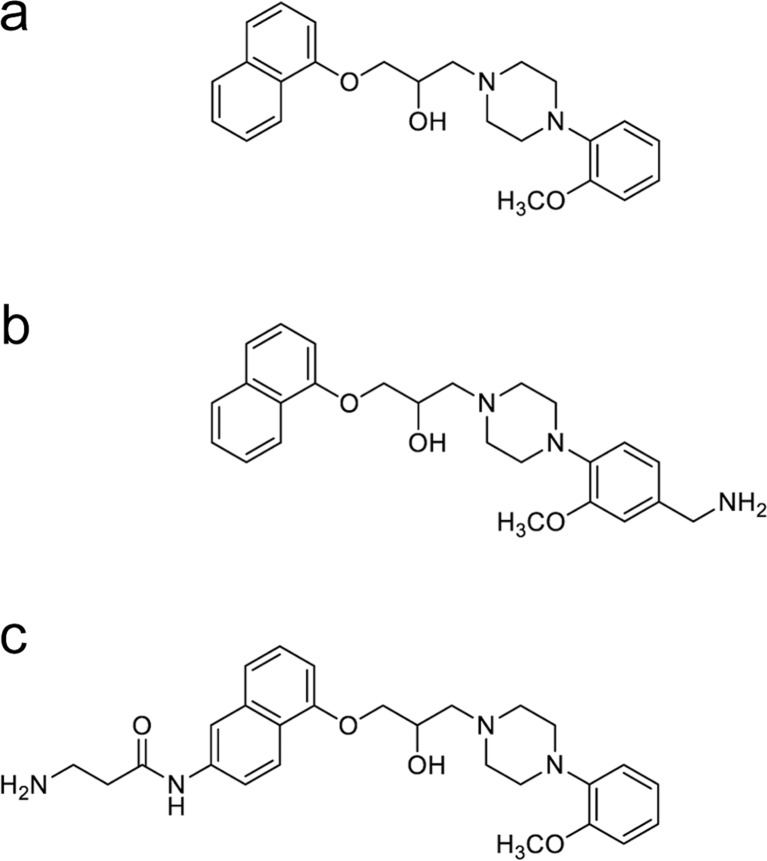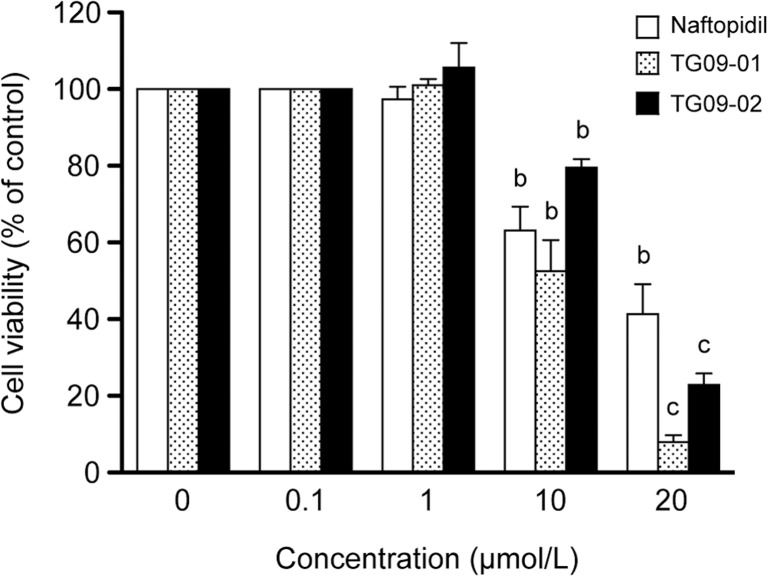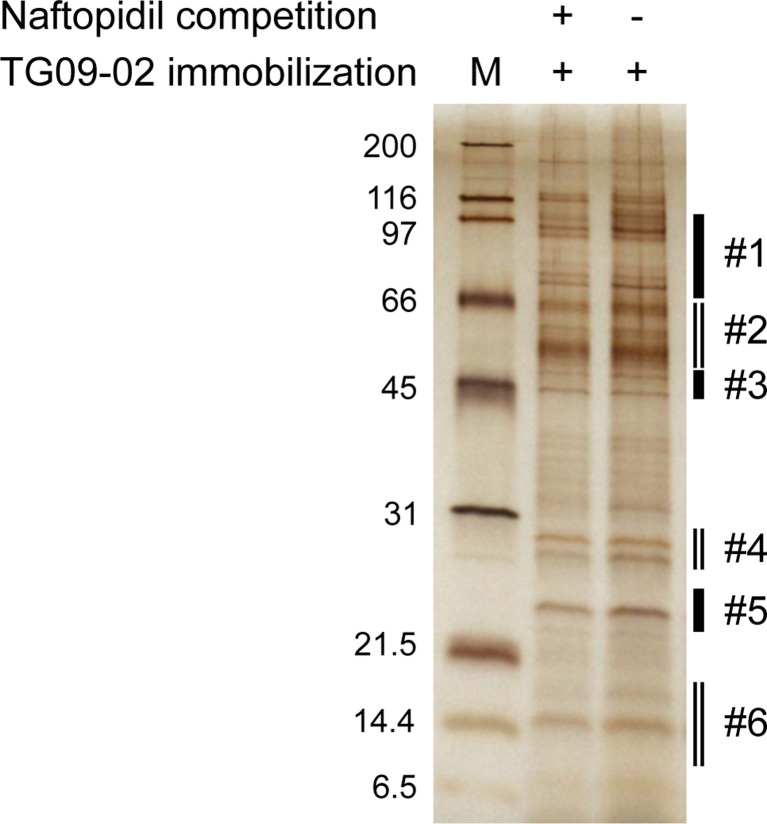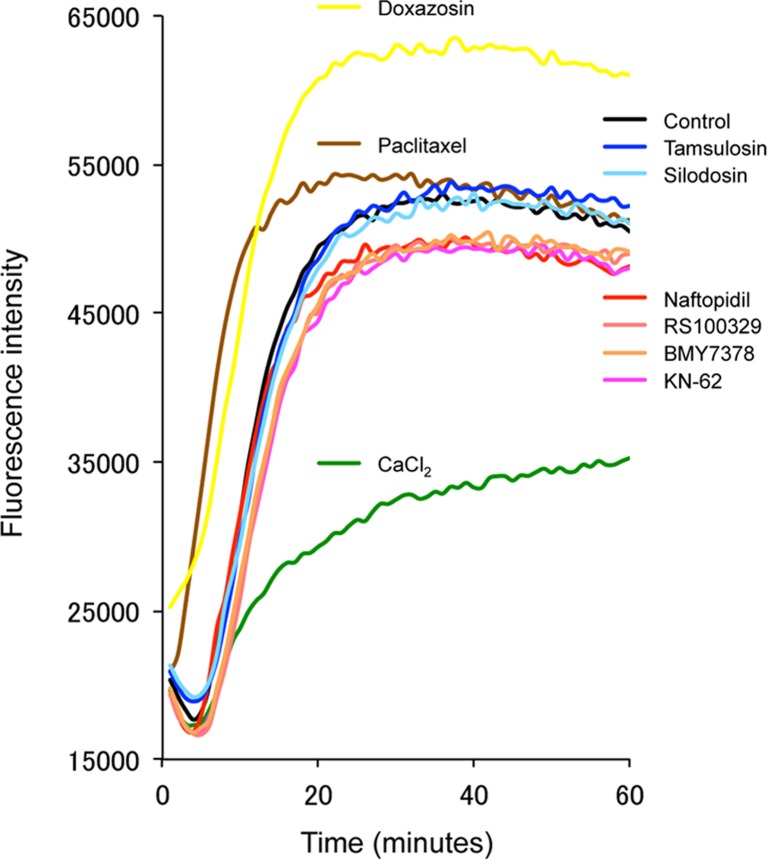Abstract
The phenylpiperazine derivative naftopidil is an α1-adrenoceptor (AR) antagonist that has been used clinically to treat benign prostatic hyperplasia. In our drug repositioning research, naftopidil shows the unique growth-inhibitory effects. Naftopidil inhibits cell cycle progression not only in cancer cells, but also in fibroblasts and vascular endothelial cells. Naftopidil-inhibited cell cycle progression is independent of α1-AR expression in cells. Therefore, the antiproliferative effects of naftopidil may be due to the off-target effects of the drug. In this study, we attempted to identify the off-target molecules of naftopidil using the magnetic nanobeads, ferrite glycidyl metharcrylate (FG) beads. Similar to naftopidil, its derivatives TG09-01 and TG09-02, which were introduced with amino groups for immobilizing to FG beads, inhibited cell growth in human HT29 colon adenocarcinoma cells. Both derivatives were associated with inhibition of cell cycle progression in HT29 cells. This observation is consistent with that seen with naftopidil. Using TG09-02-immobilized FG beads, α- and β-tubulins were identified as the specific binding proteins of naftopidil. The tubulin polymerization assay clearly indicated that naftopidil bound directly to tubulin and inhibited the polymerization of tubulin. Other phenylpiperazine derivatives, such as RS100329, BMY7378, and KN-62, also inhibited the polymerization of tubulin. These results suggest that phenylpiperazine derivatives including naftopidil may have broad spectrum of cellular cytotoxicity in various types of cells. In addition, the tubulin polymerization-inhibiting activity of phenylpiperazine derivatives may be a specific feature of the phenylpiperazine-based structure. These findings can allow us to design and synthesize new tubulin-binding drugs derived from naftopidil as a lead compound.
Keywords: Naftopidil, Phenylpiperazine-based structure, Off-target effects, Magnetic nanobeads, Tubulin polymerization
Introduction
Naftopidil (Flivas®) is one of the α1-adrenoceptor (AR) antagonists, which are referred to as α1-blockers [1]. The α1-AR antagonists, including naftopidil, have been widely used to treat benign prostatic hyperplasia (BPH), a common benign prostatic disease in elderly men. In BPH patients, α1-AR antagonists reduce prostatic smooth muscle tone and exert immediate effect on urinary flow. The α1-AR antagonists are divided into two groups based upon the differential selectivity to the α1-AR. Subtype-selective α1-AR antagonists have fewer cardiovascular side effects than subtype-nonselective α1-AR antagonists [2]. In Japan, subtype-selective α1-AR antagonists are frequently prescribed for patients with BPH because they are associated with fewer side effects.
Previously, unique growth-inhibitory effects of naftopidil have been reported, in vivo suppression of tumor growth in human prostate cancer cells and human renal cell carcinoma cells [3–5]. In vitro analyses of naftopidil showed inhibition of cell cycle progression not only in human prostate cancer cells and human renal cell carcinoma cells, but also in human prostatic fibroblasts and human vascular endothelial cells [4, 5]. Interestingly, Hori [4] demonstrated evidence that naftopidil-inhibited cell cycle progression was independent of α1-AR expression, suggesting that the antiproliferative effects of naftopidil may be due to the off-target effects of this drug.
The objective of this study was to identify the off-target molecules of naftopidil using magnetic nanobeads.
Materials and methods
Reagents
Naftopidil was purchased from Tokyo Chemical Industry Co., Ltd. (Tokyo, Japan). RS100329 and KN-62 were purchased from Tocris Bioscience (Ellisville, MO) and Merck Millipore/Calbiochem (Billerica, MA), respectively. BMY7378 and doxazosin were purchased from Sigma-Aldrich Co., LLC. (St. Louis, MO). Tamsulosin and silodosin were kindly provided by Taiho Pharmaceutical Co., Ltd. (Tokyo, Japan). Magnetic ferrite glycidyl metharcrylate (FG) beads were purchased from Tamagawa Seiki Co., Ltd. (Nagano, Japan).
Cell culture
Human HT29 colon adenocarcinoma cells were obtained from the European Collection of Cell Cultures, a Public Health England Culture Collection via DS Pharma Biomedical Co., Ltd. (Osaka, Japan). The vendor authenticated HT29 cells by the short tandem repeat-PCR method. HT29 cells were cultured in phenol red (+) RPMI-1640 supplemented with 10 % fetal bovine serum (FBS) and 1 % antibiotic/antimycotic solution.
Cell viability assay
Naftopidil and its derivatives TG09-01 or TG09-02 were dissolved in dimethylsulfoxide (DMSO). HT29 cells were seeded into 96-well culture plates at a density of 5 × 103 cells per well. After 24 h, the cells were treated with various concentrations (0, 0.1, 1, 10, and 20 μmol/L) of naftopidil, TG09-01, or TG09-02 and then incubated for 3 days. Viable cells were measured using a spectrophotometric Cell Counting Kit-8 (Dojindo Laboratories, Kumamoto, Japan) as previously described [4].
Cell cycle analysis
HT29 cells (1 × 106 cells) were seeded onto 100-mm culture dishes (Sumitomo Bakelite Co., Ltd., Tokyo, Japan). Twenty-four hours after seeding, the cells were treated with either 20 μmol/L of naftopidil, TG09-01, or TG09-02, or vehicle (0.1 % DMSO) for 24 h. After treatment, the cells were isolated and the nuclei stained using the BD Cycletest™ Plus DNA Reagent Kit (BD Biosciences, San Jose, CA). To determine cell cycle distribution, the DNA content of stained cells was analyzed on a BD FACS Canto II flow cytometer (BD Biosciences) as previously described [5].
Preparation of TG09-02-immobilized beads
Magnetic FG beads (NHS beads; TAS8848 N1141; 2.5 mg) were incubated with 10 mM triethylamine and 5-mM concentrations of TG09-02 in 500 μL of N,N-dimethylformamide for 70 min at room temperature. Unreacted residues were masked using 1.0 M ethanolamine in N,N-dimethylformamide, and the resulting TG09-02-immobilized beads were stored at 4 °C.
Preparation of cell lysates
Subconfluent cultured HT29 cells were harvested by scraping, and a whole cell lysate was prepared as previously described [6]. Briefly, the cells were cultured until 70–80 % confluent in 100-mm dishes. The cell surface was washed with ice-cold PBS and then lysed with the CelLytic™ M (Sigma-Aldrich Co. LLC., St. Louis, MO) containing 1 % Nonidet P-40, 10 mM 4-(2-aminoethyl) benzensulfonyl fluoride, 0.8 mM aprotinin, 50 mM bestatin, 15 mM E-64, 20 mM leupeptin, and 10 mM pepstatin A for 60 min on ice. The lysates were centrifuged at 10,000g for 10 min, and the supernatants were collected. The protein concentration was measured using a Bio-Rad Protein Assay Kit (Bio-Rad Laboratories, Inc., Hercules, CA).
Purification and identification of TG09-02-binding protein
The beads (0.5 mg) with and without TG09-02 were equilibrated with NP-40 lysis buffer containing 100 mM HEPES-NaOH (pH 7.9), 50 mM KCl, 1 mM MgCl2, 0.2 mM CaCl2, 0.2 mM EDTA, 10 % glycerol, 1 mM DTT, 0.2 mM PMSF, and 0.1 % NP-40, and 1.0 mg/mL cell protein fractions prepared from HT29 (1,500 μL) were incubated with beads for 4 h at 4 °C. Beads were washed three times with NP-40 lysis buffer (200 μL). Bound proteins were then eluted with sodium dodecyl sulfate (SDS) loading buffer (20 μL), separated by SDS-polyacrylamide gel electrophoresis (PAGE), and visualized by silver staining. Silver-stained bands were subjected to in-gel trypsin digestion.
Protein sequencing using mass spectrometry was performed. Recovered peptides were analyzed using Thermo Scientific LTQ Orbitrap XL mass spectrometer (Thermo Fisher Scientific Inc., Waltham, MA, USA) coupled on-line with HPLC on an L-column Micro to acquire MS/MS spectra. L-column Micro (0.1 × 150 mm) with mobile phases of A (water/formic acid, 99.9:0.1) and B (acetonitrile) was used. Peptide mass fingerprinting was used for protein identification from tryptic fragment sizes using the Mascot search engine (http://www.matrixscience.com) querying the entire NCBI database of theoretical human peptide masses.
Tubulin polymerization assay
The effects of naftopidil and other drugs such as tamsulosin, silodosin, doxazosin, RS100329, BMY7378, and KN-62 on tubulin polymerization were monitored using the standard assay protocol of a porcine tubulin-based commercial kit (Tubulin Polymerization Assay Kit, Cytoskeleton Inc., Denver, CO), which utilizes fluorescent reporter enhancement. Fluorescence was measured using 2030 ARVO™ X (PerkinElmer Co., Ltd., Waltham, MA). Excitation was at 360 nm and emission at 420 nm. Naftopidil and other drugs were evaluated at 15 μmol/L final concentration. Paclitaxel (3 μmol/L) and calcium chloride solution (500 μmol/L) were used as positive controls.
Statistical analysis
The results were expressed as the mean ± SD. Differences between the two groups were determined using a Student’s t test. Values of p < 0.05 were considered statistically significant.
Results
Naftopidil shows antiproliferative activity accompanied by inhibition of cell cycle progression; however, its direct molecular targets remain elusive. Naftopidil must have common molecular targets because naftopidil is effective in various types of cells including not only cancer cells, but also fibroblasts and vascular endothelial cells. To identify the primary target proteins of naftopidil, a technique involving FG beads to isolate the specific binding proteins of naftopidil was used [7]. We prepared the naftopidil derivatives TG09-01 and TG09-02 by introducing the amino group into naftopidil for immobilizing to FG beads (Fig. 1).
Fig. 1.
Chemical structures of naftopidil and its derivatives. a Naftopidil. b TG09-01. c TG09-02
The structure-activity relationships between naftopidil and its derivatives in evaluation of their antiproliferative activity were investigated. As with naftopidil, both TG09-01 and TG09-02 inhibited cell growth of HT29 cells in a dose-dependent manner (Fig. 2), suggesting that an additional substituent amino group on TG09-01 or TG09-02 did not affect the antiproliferative activity of parental naftopidil.
Fig. 2.
Effects of naftopidil and its derivatives on cell proliferation in HT29 cells. HT29 cells were exposed to 0.1, 1, 10, and 20 μmol/L compounds (naftopidil, TG09-1, or TG09-02) for 3 days, and then, cell viability of HT29 cells was evaluated using Cell Counting Kit-8. Values that represent the mean ± SD percentage of viable cells are shown. b p < 0.01, c p < 0.001 versus vehicle-treated control
The effects of naftopidil, TG09-01, and TG09-02 on cell cycle progression were compared in HT29 cells. As shown in Table 1, both TG09-01 and TG09-02 were associated with G1 cell cycle arrest as was naftopidil.
Table 1.
Effects of naftopidil and its derivatives on the cell cycle progression of HT29 cells
| Phase (%) | |||
|---|---|---|---|
| G0/G1 | S | G2/M | |
| Control | 63.6 ± 1.0 | 24.8 ± 0.1 | 10.6 ± 0.7 |
| Naftopidil | 77.0 ± 1.1*** | 15.0 ± 1.1** | 7.1 ± 0.2* |
| TG09-01 | 68.7 ± 1.2** | 18.9 ± 0.8** | 10.2 ± 0.6 |
| TG09-02 | 71.7 ± 1.6** | 18.6 ± 1.5* | 8.9 ± 0.3* |
*p < 0.05; **p < 0.01; ***p < 0.001 versus vehicle-treated control
Magnetic FG beads are structurally unique; they contain large ferrite nanoparticles compared with conventional magnetic beads [8]. During analysis of competitive inhibition using parental naftopidil, representative SDS gel images showed several TG09-02-binding protein bands (Fig. 3). The specific binding proteins were divided into the six areas #1–#6 and then applied to LC-MS/MS analysis.
Fig. 3.
Specific binding proteins to TG09-02-immobilized magnetic nanobeads using SDS-PAGE. TG09-02 was covalently conjugated to FG beads and incubated with protein fractions of HT29 cells. The bound proteins were eluted and subjected to SDS gel electrophoresis and silver staining. The specific binding proteins were divided into the six areas #1–#6 and then applied to LC-MS/MS analysis. M protein marker
Several TG09-02-binding proteins, including importing 7, exporting 2, glycogen phosphorylase B, 17β-hydroxysteroid dehydrogenase 12, SUB1, Sec61, and ribosomal protein P2, were identified. An area of #2 contained α- and β-tubulin, as identified by LC-MS/MS. In these experiments, α-tubulin showed 9.8 % protein sequence coverage and 100 % protein identification probability. Concomitantly, β-tubulin had 9.2 % protein sequence coverage and 100 % protein identification probability. Both of these proteins have a molecular weight of approximately 50 kDa. These results suggest that naftopidil specifically interacts with both α-tubulin and β-tubulin subunits, thereby affecting microtubule function.
To investigate the effects of naftopidil on microtubule function, bovine brain tubulin (>99 % pure) was treated with naftopidil; other phenylpiperazine derivatives such as RS100329, BMY7378, and KN-62; and other α1-AR antagonists such as tamsulosin, silodosin, and doxazosin for 60 min at 37 °C. Paclitaxel and CaCl2 were used as positive controls; paclitaxel enhanced tubulin polymerization, and CaCl2 inhibited tubulin polymerization. The phenylpiperazine derivatives including not only naftopidil but also RS100329, BMY7378, and KN-62 showed tubulin polymerization-inhibiting activity (Fig. 4). In contrast, both tamsulosin and silodosin did not show any effect on tubulin polymerization. Interestingly, doxazosin enhanced tubulin polymerization.
Fig. 4.
Effects of naftopidil and other phenylpiperazine derivatives on tubulin polymerization in vitro. A tubulin preparation was incubated at 37 °C in the presence or absence (control) of naftopidil; other phenylpiperazine derivatives such as RS100329, BMY7378, and KN-62; and other α1-AR antagonists such as tamsulosin, silodosin, and doxazosin. Naftopidil and other drugs were evaluated at 15 μmol/L final concentration. Paclitaxel (3 μmol/L) and calcium chloride solution (500 μmol/L) were used as positive controls
Discussion
Previously, it has been reported that naftopidil strongly suppresses cell proliferation in cancer cells and also fibroblasts and vascular endothelial cells [3–5]. The important finding was that the antiproliferative effects of naftopidil were independent of α1-AR expression in cells, suggesting that naftopidil may inhibit cell cycle progression in various types of cells. No evidence of naftopidil-induced apoptosis was observed, evidenced by Hoechst 33258 staining, DNA ladder formation, and PARP cleavage [3].
Our results have demonstrated that naftopidil binds to tubulin and inhibits tubulin polymerization, suggesting the possibility that naftopidil has broad spectrum of cellular cytotoxicity in cancer cells in addition to fibroblasts and vascular endothelial cells. It has been well established that tubulin-binding drugs suppress the microtubule dynamics and disrupt the formation of mitotic spindles, resulting in inhibition of cell cycle progression [9]. In addition, it has been reported that tubulin-binding agents substantially disrupted small blood vessel formation during tumorigenesis [10, 11]. Prominent examples of tubulin-binding drugs include the taxanes, such as Taxol and Taxotere, and the vinca alkaloids, such as vincristine, vinorelbine, and vinblastine. In this study, the phenylpiperazine derivatives RS100329, BMY7378, and KN-62 also inhibited tubulin polymerization as does naftopidil.
In general, modification of the substituent group changes the properties of the compound, resulting in other effects on cells. The results of the in vitro tubulin polymerization assay demonstrated that the phenylpiperazine derivatives inhibited tubulin polymerization. The structural requirement for its inhibiting activity seems to be critical, because other drugs investigated, including tamsulosin (Harnal®), silodosin (Urief®), and doxazosin (Cardenarin®), showed no tubulin polymerization-inhibiting activity (tamsulosin and silodosin) or tubulin polymerization-enhancing activity (doxazosin). Thus, the results of our study strongly suggest that differences in antiproliferative mechanisms among α1-AR antagonists are mainly attributable to their chemical structures.
Hori demonstrated evidence that the phenylpiperazine derivatives naftopidil and RS100329 inhibited cell cycle progression [4]. In contrast, the other phenylpiperazine derivative α1D-selective antagonist BMY7378 did not inhibit cell cycle progression at a low concentration (10 μmol/L), whereas five times the concentration of BMY7378 weakly inhibited cell cycle progression [4]. This might be explained by a difference in the cell membrane permeability among the drugs investigated.
Generally, the tubulin polymerization inhibitors arrest the cell cycle in G2 phase but not in G1 phase. In contrast, we have reported that tubulin-binding naftopidil arrests the cell cycle in G1 phase but not in G2 phase [3–5]. In similar with naftopidil, the tubulin polymerization inhibitors coptisine and thiazolidinediones arrest the cell cycle in G1 phase [12, 13]. Our investigation in this study was not able to verify how naftopidil-treated cancer cells escaped the cell cycle in G2 phase. Identification of the binding site of naftopidil to tubulin proteins may help us to understand how tubulin-binding naftopidil acts on the cell cycle of cancer cells. To verify the relationship between the action of tubulin-binding naftopidil and the induction of G1 cell cycle arrest, we need further investigation.
Many existing tubulin-binding drugs have limited oral activity and often require intravenous administration, resulting in discomfort and inconvenience for patients with cancer [14]. Adverse effects associated with these tubulin-binding drugs frequently lead to treatment discontinuation. High tolerability is important for continued administration of drugs. Thus, the development of a well-tolerated orally active inhibitor of microtubule dynamics would provide a substantial improvement in the range of treatment options for patients with cancer.
The incidence of BPH increases with age, and orally active α1-AR antagonists are widely prescribed for patients with BPH. Oral administration of α1-AR antagonists for BPH often precedes diagnosis of various types of cancers. Naftopidil has high tolerability because of fewer side effects [15, 16]. Therefore, there may be some prospective clinical benefits from long-term use of orally active naftopidil for patients with BPH. Naftopidil might be an ideal drug candidate for chemoprevention in various types of cancers.
In this study, we have discovered a novel family of phenylpiperazine derivatives, particularly naftopidil, that may overcome several difficulties in the use of existing tubulin-binding drugs. Our results suggest that the tubulin polymerization-inhibiting activity of phenylpiperazine derivatives is a specific feature of the phenylpiperazine-based structure. These findings can allow us to design and synthesize new tubulin-binding drugs derived from naftopidil as a lead compound.
Acknowledgments
We thank Mrs. Yumi Yoshikawa for technical support. This work was supported by Grants-in-Aid from the Ministry of Education for Science and Culture of Japan (23791751).
References
- 1.Kawabe K (2006) Latest frontiers in pharmacotherapy for benign prostatic hyperplasia. Yakugaku Zasshi 126 Spec no.: 199–206 [DOI] [PubMed]
- 2.Roehrborn CG, Schwinn DA. Alpha1-adrenergic receptors and their inhibitors in lower urinary tract symptoms and benign prostatic hyperplasia. J Urol. 2004;171:1029–1035. doi: 10.1097/01.ju.0000097026.43866.cc. [DOI] [PubMed] [Google Scholar]
- 3.Kanda H, Ishii K, Ogura Y, Imamura T, Kanai M, et al. Naftopidil, a selective alpha-1 adrenoceptor antagonist, inhibits growth of human prostate cancer cells by G1 cell cycle arrest. Int J Cancer. 2008;122:444–451. doi: 10.1002/ijc.23095. [DOI] [PubMed] [Google Scholar]
- 4.Hori Y, Ishii K, Kanda H, Iwamoto Y, Nishikawa K, et al. Naftopidil, a selective {alpha}1-adrenoceptor antagonist, suppresses human prostate tumor growth by altering interactions between tumor cells and stroma. Cancer Prev Res (Phila) 2011;4:87–96. doi: 10.1158/1940-6207.CAPR-10-0189. [DOI] [PubMed] [Google Scholar]
- 5.Iwamoto Y, Ishii K, Sasaki T, Kato M, Kanda H, et al. Oral naftopidil suppresses human renal-cell carcinoma by inducing G(1) cell-cycle arrest in tumor and vascular endothelial cells. Cancer Prev Res (Phila) 2013;6:1000–1006. doi: 10.1158/1940-6207.CAPR-13-0095. [DOI] [PubMed] [Google Scholar]
- 6.Ishii K, Imamura T, Iguchi K, Arase S, Yoshio Y, et al. Evidence that androgen-independent stromal growth factor signals promote androgen-insensitive prostate cancer cell growth in vivo. Endocr Relat Cancer. 2009;16:415–428. doi: 10.1677/ERC-08-0219. [DOI] [PubMed] [Google Scholar]
- 7.Liu J, Shimizu K, Tanaka A, Shinobu W, Ohnuki K, et al. Target proteins of ganoderic acid DM provides clues to various pharmacological mechanisms. Sci Rep. 2012;2:905. doi: 10.1038/srep00905. [DOI] [PMC free article] [PubMed] [Google Scholar]
- 8.Nishio K, Masaike Y, Ikeda M, Narimatsu H, Gokon N, et al. Development of novel magnetic nano-carriers for high-performance affinity purification. Colloids Surf B: Biointerfaces. 2008;64:162–169. doi: 10.1016/j.colsurfb.2008.01.013. [DOI] [PubMed] [Google Scholar]
- 9.Jordan MA, Wilson L. Microtubules as a target for anticancer drugs. Nat Rev Cancer. 2004;4:253–265. doi: 10.1038/nrc1317. [DOI] [PubMed] [Google Scholar]
- 10.Belleri M, Ribatti D, Nicoli S, Cotelli F, Forti L, et al. Antiangiogenic and vascular-targeting activity of the microtubule-destabilizing trans-resveratrol derivative 3,5,4′-trimethoxystilbene. Mol Pharmacol. 2005;67:1451–1459. doi: 10.1124/mol.104.009043. [DOI] [PubMed] [Google Scholar]
- 11.Schwartz EL. Antivascular actions of microtubule-binding drugs. Clin Cancer Res. 2009;15:2594–2601. doi: 10.1158/1078-0432.CCR-08-2710. [DOI] [PMC free article] [PubMed] [Google Scholar]
- 12.Tanabe H, Suzuki H, Mizukami H, Inoue M. Double blockade of cell cycle progression by coptisine in vascular smooth muscle cells. Biochem Pharmacol. 2005;70:1176–1184. doi: 10.1016/j.bcp.2005.07.010. [DOI] [PubMed] [Google Scholar]
- 13.Russu WA. Thiazolidinedione anti-cancer activity: is inhibition of microtubule assembly implicated? Med Hypotheses. 2007;68:343–346. doi: 10.1016/j.mehy.2006.06.054. [DOI] [PubMed] [Google Scholar]
- 14.Kuppens IE. Current state of the art of new tubulin inhibitors in the clinic. Curr Clin Pharmacol. 2006;1:57–70. doi: 10.2174/157488406775268200. [DOI] [PubMed] [Google Scholar]
- 15.Yokoyama T, Kumon H, Nasu Y, Takamoto H, Watanabe T. Comparison of 25 and 75 mg/day naftopidil for lower urinary tract symptoms associated with benign prostatic hyperplasia: a prospective, randomized controlled study. Int J Urol. 2006;13:932–938. doi: 10.1111/j.1442-2042.2006.01443.x. [DOI] [PubMed] [Google Scholar]
- 16.Tsuritani S, Nozaki T, Okumura A, Kimura H, Kazama T. A prospective, randomized, controlled, multicenter study of naftopidil for treatment of male lower urinary tract symptoms associated with benign prostatic hyperplasia: 75 mg once daily in the evening compared to 25 mg thrice daily. Urol Int. 2010;85:80–87. doi: 10.1159/000315994. [DOI] [PubMed] [Google Scholar]






